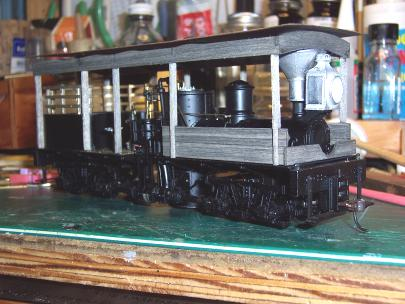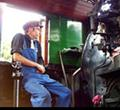
Digital cameras are really nice, great pictures no matter the amount
or type of lighting, and no processing fees for unwanted photos.
With these advantages, digital photography can help improve our modeling,
help write an article, as well as document our layout. All you need a
camera that will allow close-up photography and a tripod. As you build,
paint and weather a model, take several pictures from different angles
at the end of each step. I take them right on my model-building workbench
with a piece of heavyweight white paper to hide most of my tools and other
clutter, and to give a plain background with no distractions. Take these
with AND without the flash, experiment here with your available light,
(a cheap, adjustable-arm desk light from Wal-Mart with a 60W bulb works well,
and you can play around with the lighting angle). I then download the photos
to the computer, and then delete any that didn’t turn out decent. Then I study
them on the computer, usually before I retire for the evening. Before I move
on to that next step, I’ll look at the photos again. I have found that
this helps me to spot bad glue joints, incorrectly bent piping, paint
problems or other “glitches” in my model. When it looks right in the
photo, it should look even better in person. Remember, you’re not
paying to get the film developed, so click away.
If you plan on writing an article for publication, take the pictures
with at least a 4-megapixel camera. If you take photos of trains on
your layout, take them in color; many cameras have sepia and black &
white options. But, most photo handling programs have this also, and
with the program you can save the same picture in color, sepia and B&W.
Play around a bit.
One more note on digital cameras: they are not created equal. I have
two 4-megapixel cameras by the same manufacturer. One has a 3X optical
lens (cheaper) and the other has a 10X optical lens (pricier). The 3X
will zoom in at a much closer distance than the 10X will. The minimum
focal length for the 3X is 9 inches and the zoom does not affect this
distance. The 10X, however, has a minimum focal length of about 4
inches, but at around 7X+, this distance is now 2 ½ - 3 feet!! Kind
of defeats the purpose, huh? Bigger is not always better. (Don’t
even worry about “digital zoom”; this just makes the pixels bigger,
giving the photo a “grainy effect.)
Now, go get busy on that Christmas ornament, I mean that new building
for the layout. Next time we’ll talk about “Rubber Gauging”. Until
then, remember: It’s your club - get involved!
Let’s play trains!



